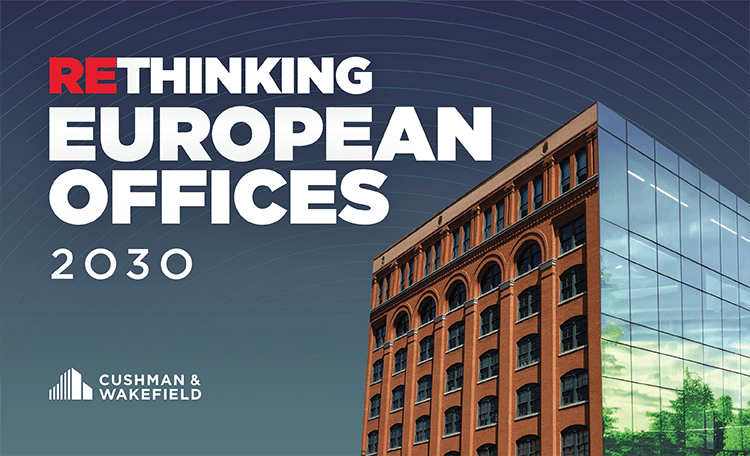Tax relief for companies could have an impact in the medium term
Cushman & Wakefield, a global real estate consultancy, recorded office take-up of around 573,000 m² in the five most important office locations in Germany (Berlin, Düsseldorf, Frankfurt, Hamburg and Munich) in the second quarter of 2025. This is 2 per cent more than in the same period of the previous year.
A look at the half-year figures reflects the strong start to 2025 and resulted in a significant increase of 9 per cent. A total of 1.16 million m² was taken up in the first six months (H1 2024: 1.07 million m²). This corresponds to a slight increase of 2 per cent compared to the 5-year average for the first half of each year. With the exception of Frankfurt, all markets showed rather subdued momentum, characterised by multidimensional uncertainties.
Tina Reuter, CEO Germany at Cushman & Wakefield, comments on the current situation on the German letting markets as follows: "Geopolitical instability, US customs policy, differences in the EU with regard to relevant economic policy issues and, last but not least, changes in the behaviour of workforces with regard to where they work and the associated tendency to work from home often make companies reluctant to initiate fundamental changes in office use. However, the tax relief for companies promised by the German government could certainly have an effect in the medium term and contribute to the dynamisation of the rental market, albeit only marginally at first."
Pierre Nolte, Head of Offices & Leasing Germany at Cushman & Wakefield, adds and comments specifically on the office letting markets of the top 5 in Germany: "From an overall perspective, it is becoming increasingly apparent that central locations and new, modern or refurbished office space are the focus of corporate space decisions. Some of the top lettings in the first half of 2025 are highlighted as examples in this context. In Frankfurt, for example, space was rented in prime locations and peripheral locations were left behind. If it is allowed to be a peripheral location, as in Düsseldorf for Helaba, then it is due to the strategically favourable location within the city and the proximity to the old company headquarters."
Office take-up: ups and downs in the top 5 markets - Frankfurt dominates statistics
Take-up in the top 5 markets continues to vary considerably from region to region. While Berlin and Düsseldorf were able to increase compared to the start of the year, the take-up volume in Frankfurt, Hamburg and Munich in the second quarter was below that of the first three months of 2025.
Take-up in Frankfurt remained at a high level in the 2nd quarter with a volume of 144,000 m². In the first half of 2025, take-up was just under 339,000 m², a remarkable increase of 86 per cent compared to the previous year. No other of the top 5 was able to achieve a similar level in both absolute and relative terms. In addition to the metropolis on the Main, Hamburg (+ 9 per cent) remained in the plus in the half-year comparison at a good 213,000 m². Berlin reported a take-up volume of exactly a quarter of a million m² in the first half of the year (- 14 per cent compared to the same period last year). The Bavarian capital performed similarly with 261,000 m² and a drop of 10 per cent. Despite a good quarterly volume of 65,100 m², achieved among other things by the largest regional letting of 7,800 m² in "Heylo" by the NRW branch of the Hessisch-Thüringische Landesbank Helaba brokered by Cushman & Wakefield, Düsseldorf suffered a decline of 9 per cent in the half-year statement with 103,000 m².
From a regional perspective, the top deals of the 2nd quarter of 2025 are evenly distributed: All five metropolises are represented at least once among the seven largest deals, whereby the two largest lettings in Frankfurt (Parktower - top 1 with around 21,000 m² and Opernturm - top 4 with around 13,000 m²) were concluded by one user (KPMG) as a "complete package". It is also striking that the public sector accounted for the largest take-up in three of the top 5 (Hamburg, Munich and Berlin).

Prime rents continue to rise almost everywhere - lower average rents in Berlin and Düsseldorf
In four of the top 5, an increase in achievable prime rents was recorded in the second quarter compared to both the first quarter of 2025 and the same period of the previous year. According to Cushman & Wakefield, the Bavarian and North Rhine-Westphalian state capitals saw the strongest year-on-year increase of over 7 per cent to EUR 55 and EUR 45/m²/month respectively. Since the previous quarter, it has also been over EUR 50 in Frankfurt (+5.2 per cent in a 12-month comparison to EUR 51/m²/month at the end of Q2 2025).
In contrast, the weighted average rent achieved in the top 5 cities shows different trends. While an average rent of EUR 32.50/m²/month was recorded in Frankfurt thanks to a remarkable increase of 30 per cent and (almost) double-digit growth was also recorded in Hamburg (+10 per cent) and Munich (+9.6 per cent), rents in Berlin and Düsseldorf fell by around 3 per cent. This means that by mid-2025, only Düsseldorf will have an average rent of less than EUR 20.

Vacancy rates with increase in all top 5 markets
Despite declining completion volumes and rising take-up, vacancy rates in the top 5 markets are trending upwards. With an average increase of 1.4 percentage points year-on-year, Munich stands out in particular with an increase of 1.9 percentage points to 8.2 per cent and Berlin, which is approaching the 10 per cent mark with +1.7 percentage points to 9.6 per cent. Düsseldorf and Frankfurt have been above the 10 per cent mark since the previous year, rising by a comparatively low +0.4 and+ 1.0 percentage points to 10.5 per cent and 11.1 per cent respectively in the 12-month period.

Further decline in completions
The statistics on completions in the five German metropolises confirm their downward trend in the first half of 2025: the year-on-year decline was still around a quarter by the middle of the year. Around 475,000 m² of office space was reported as completed. While volumes in Frankfurt 2025 are still below the 10,000 m² mark at a very low level, with a drop of almost 90 per cent, Düsseldorf can report brisk construction activity for the first six months, which at around 97,000 m² is more than double the previous year's figure. There are also positive signs on the Elbe, where more than 100,000 m² of new office space will appear in the statistics after the first half of 2025. There was also a sharp decline in the Berlin market (-43 per cent to around 170,000 m²) and in Munich, which just missed the 100,000 m² mark.
At the end of June 2025, around 2.85 million m² of office space was under construction in the top 5. Berlin alone accounts for more than a third of the space under construction with a volume of over 1 million m², followed by Munich with around 640,000 m². The occupancy rate here is only 36 per cent and 40 per cent respectively. In Hamburg and Frankfurt - with significantly lower volumes of around 412,000 m² (Frankfurt) and 440,000 m² (Hamburg) - more than 60 per cent of space is already occupied.






